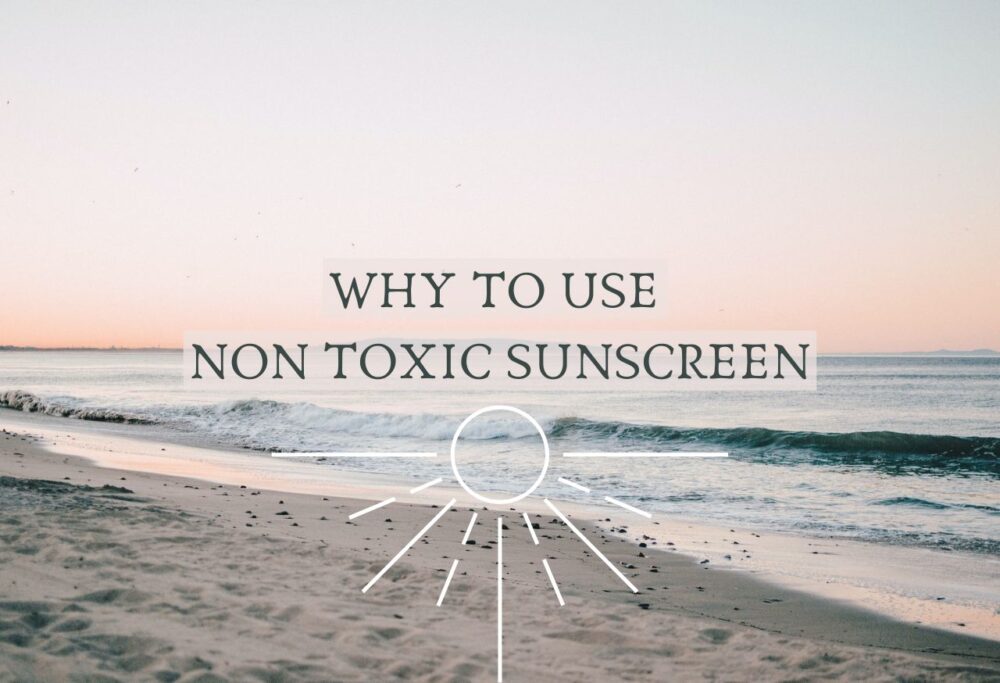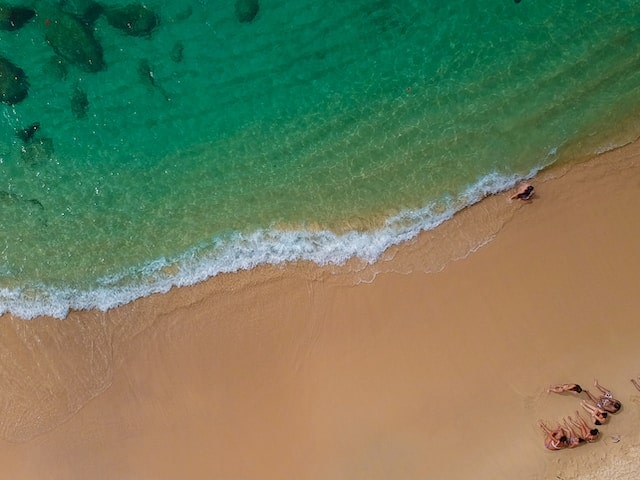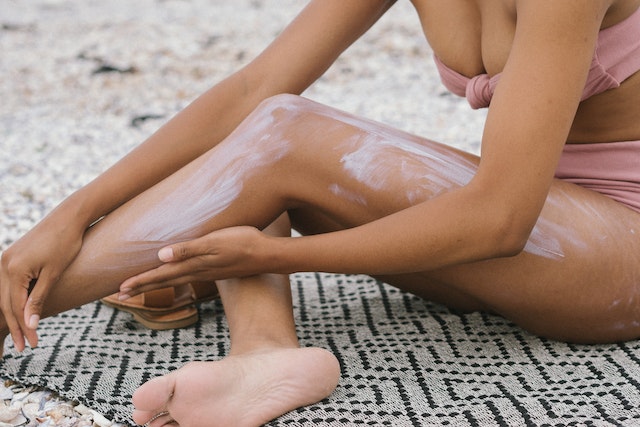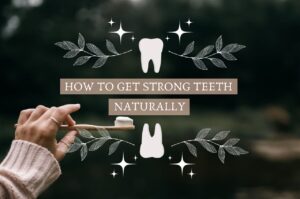This post is about why non toxic sunscreen is the best sunscreen you can use both for your health and the planet.
If you are a bit skincare obsessed like me, you know sunscreen is one of the most important skincare products to use in your skincare routine. I’ve been binging skincare tips from dermatologists lately, and one thing they repeat again and again: without using a sunscreen on your face and neck daily, the rest of your skincare work is kind of thrown away.
Because to avoid premature aging, hyperpigmentation and even acne, protection of the skin must come first. Especially during summertime, when the sun is becoming stronger, it becomes even more important to protect your exposed skin with a sunscreen.
But not all sunscreens are created equal. And not every sunscreen is good for the rest of your health or the environment. Many studies have proven that sunscreen often contains chemicals that can disrupt our hormones and destroy coral reefs. In fact, 2020 Palau became the first county that banned 11 common chemicals in sunscreens to protect marine ecosystem and coral reefs!
So how do we know which sunscreen to use? To make sure you protect your skin, your health and the earth? Keep on reading to learn about chemical and mineral sunscreens and why using a non toxic sunscreen is the best!
A little bit about SPF and why we need it
Why do we need SPF?
Why the need to use SPF at all? Well let me tell you! The sun is vital for all life on earth, but too much of this lovely warm sunshine can actually be damaging.
The sun emits a type of energy called UV radiation. There are three types of UV radiation: UVA, UVB & UVC. We don’t need to protect ourselves against UVC because the ozone layer of the earth already blocks this for us. However, UVA & UVB reaches us and therefore we need to take them into consideration.
UVB radiation has short wavelengths that only reach the outer layers of our skin. One health benefit of UVB is that it triggers vitamin D production in our skin, which is an essential vitamin for our health. However, UVB can also burn the skin, damage skin cells and cause inflammation if we stay out in the sun for too long. Over exposure to UVB can also cause skin cancer, because too much UVB exposure damages the DNA in our skin cells.
UVA radiation has longer wavelengths that penetrate deeper into the skin tissue and go through both clouds and windows. UVA makes you tan quickly. But too much exposure to UVA will lead to premature aging, oxidative stress and damage to the skin cells, which also can lead to skin cancer.
To avoid premature aging, skin cell damage, inflammation and skin cancer, you need to protect your skin from overexposure from the sun. Which is where an SPF comes in handy!
What is SPF?
SPF stands for sun protecting factor. It is a measure of how much UVB radiation the skin can withstand before burning compared to unprotected skin.
A common misconception is that SPF 15 means that you can stay in the sun 15 times longer (for example, 15 hours instead of 1 hour). But it’s not about time. SPF 15 means your skin can withstand 15 times more UV radiation before burning, compared to wearing no SPF at all. This can’t be measured in time because the amount of UV radiation fluctuates during the day. For example, 1 hour in the sun at 9 am can equal the same amount of UV radiation as 15 minutes in the sun at 1 pm.
Another thing that many people don’t know, is that the amount of UVB protection isn’t proportional to the SPF number. The effectiveness of SPF actually levels out when it comes over 15.
| SPF 2 | Blocks 50% of UVB rays |
| SPF 4 | Blocks 75% of UVB rays |
| SPF 10 | Blocks 90% of UVB rays |
| SPF 15 | Blocks 93% of UVB rays |
| SPF 30 | Blocks 97% of UVB rays |
| SPF 50 | Blocks 98% of UVB rays |
| SPF 100 | Blocks 99% of UVB rays |
As you can see, the difference between SPF 30 and 50 is actually just 1%. A sunscreen with SPF above 50 is quite unnecessary because they are way more expensive and only zero point something more effective than SPF 50!
Some quick facts about sunscreen and UV radiation:
-
- Fair skinned people absorb more UV radiation and therefore burn quicker than dark skinned people.
- The UV radiation is the highest at midday (between 11.00-15.00).
- On cloudy days, the UVB radiation is less compared to sunny days, but you still need to protect yourself because UVA radiation more or less stays the same.
- UV rays are stronger around the equator because the sun rays don’t need to travel as far to reach the earth.
- SPF on the sunscreen tells you how much UVB radiation is blocked, but doesn’t apply to UVA. That’s why you always should get a broad spectrum labeled sunscreen as it also blocks UVA. The broad spectrum label is regulated and means that the sunscreen provides at least 1/3 protection agains’t UVA compared to the noted SPF. For example: SPF 30 blocks 1/3 of the UVA, which makes it SPF 10 = 89% UVA protection.
Chemical sunscreens VS Mineral sunscreen
There are two types of sunscreens: chemical sunscreens and mineral sunscreens. The difference between the two are the active ingredients that provide the UV protection. Just like the name applies, the chemical sunscreen contains chemical active ingredients that protect you from the sun. And mineral sunscreens, also called physical sunscreens, contain mineral active ingredients.
What is a Chemical sunscreen?
Chemical sunscreen contains chemical actives to protect you from the sun. These ingredients are absorbed by the skin and in turn absorb all the harmful UV radiation your skin is exposed to. Then it transforms the UV radiation into heat by a chemical reaction, making the UV radiation harmless. In this process, the chemical actives break down. Which is why you need to reapply SPF every two hours or more frequently if you are in the water or sweating a lot.
Some chemical UV blockers are:
-
- oxybenzone / benzophenone-3
- avobenzone
- octisalate
- octocrylene
- homosalate
- octinoxate / octyl methoxycinnamate
A great benefit to chemical sunscreens is that they easily sink into the skin, are easy to distribute and don’t leave a white cast on the skin. The downside of chemical sunscreens are that they can be irritating to sensitive skin, can clog pores and worst, have shown to be harmful to our health and marine life.
What is a mineral sunscreen?
Mineral sunscreen contains mineral actives to protect you from the sun. Instead of absorbing UV radiation like a chemical sunscreen, a mineral sunscreen remains topical and acts as a protective barrier on the skin. The small active particles reflect back the harmful UV radiation which your skin is exposed to and so protect it.
There are only two mineral actives: Zinc oxide and titanium oxide.
The greatest benefit is that they are safe for our health and the environment. A downside of mineral sunscreen is that it often leaves a white cast on the skin. However, nowadays mineral sunscreens have improved a lot, so there are also mineral sunscreens that are tinted or do not leave any visible residue. Using mineral sunscreen doesn’t necessarily mean you have to look like a ghost!
Why to avoid chemical sunscreens
The skin is our biggest organ and capable of absorbing what’s applied topically if the chemicals are small enough to pass the skin barrier. This is why we have to be mindful about what we put on our skin! Here is a list of what effect chemical sunscreens can have on nature and our bodies and why it’s better to avoid them.
1. Chemical sunscreens can be harmful to human health
The most concerning factor of chemical sunscreen is that our skin absorbs many of the chemical ingredients. Several studies show that the chemicals oxybenzone, octinoxate, octisalate, octocrylene, homosalate and avobenzone are systematically absorbed by the body and could be found in the blood, urine, breastmilk and on the skin weeks after it last had been used.
But the problem isn’t necessarily the absorption itself. The problem is the negative effect the absorbed chemcial can have on our health. Many chemical UV blockers have shown to be endocrine disruptive, which means they disturb healthy hormone levels in our body. As our hormone health is crucial for the rest of health, especially for women, hormone disruption is something we want to avoid at all cost.
Some sunscreen ingredients that have shown to be endocrine disruptive are: oxybenzone, octinoxate and avobenzone. By using a sunscreen with these ingredients you are therefore applying hormone disruptive chemicals on your skin, which in turn can disrupt your health. Of course this is something we want to avoid if we value our health!
2. Chemical sunscreens are harmful to the earth and marine life
While you intend sunscreen to only stay on your skin, it doesn’t. When we swim in water or take a shower, the sunscreen is washed away and enter our waterways. There these chemical ingredients have an impact on the ecosystem. Scientists have found that chemical sunscreen actives affect both plants and animals negatively.
For example, oxybenzone and octinoxate have shown to be especially harmful for marine life. It causes coral bleaching, causes DNA damage and deforms and kills young corals. It also causes reproductive system damage and fertility problem in fish and dolphins and bioaccumulates in their tissue.
Palau, Hawaii, U.S Virgin Islands, Key West Florida, Aruba, Bonaire, eco reserves in Mexico and marine national parks in Thailand have already included many chemical sunscreen ingredients in their sunscreen ban since 2020. This to protect marine ecosystem and coral reefs from destruction.
3. Chemical sunscreen actives are not FDA approved.
Did you know that not one chemical sunscreen active is FDA approved? While some chemical actives have been classified as unsafe (aminobenzoic acid & trolamin salicylate, which are now banned), the others need more research to prove that they are both safe and effective. The only two that are classified as both safe and effective are, yes you guessed it, zinc oxide & titanium dioxide, which are both mineral actives.
In 2021, Europe set a restriction that doesn’t allow there to be more than 2.2 percent for oxybenzone and 1.4 percent for homosalate in a product. This because the current exposure to those ingredients were seen as unsafe. In America this isn’t the case so the concentrations can be up to 6%, which is why you should be extra careful if you’re buying sunscreen from an American brand.
4. Chemical sunscreens can irritate sensitive skin, increase redness and clog pores
Chemical sunscreen can irritate sensitive skin and increase break outs on acne prone skin. This because the chemical actives are more likely to cause irritation and clog pores. Also the extra heat that’s created from the chemical reaction to neutralize the UV radiation, can cause the skin on your face to redden. If you are already struggling with redness or rosacea, a chemical sunscreen could make these symptoms worse.
Often chemical sunscreens also contain more ingredients such as stabilizers, preservatives and fragrances. If you have sensitive skin that gets irritated, red or breaks out easily, dermatologists recommend to avoid chemical sunscreen and go for a mineral sunscreen instead.
Why to use a non-toxic mineral sunscreen
After reading the disadvantages of a chemical sunscreen, your may begin to understand why mineral sunscreen is the better option for your health and the planet. Here are all the reasons why you should choose a non-toxic mineral sunscreen!
1. Non-toxic sunscreen is safer for your health.
Non-toxic mineral sunscreen works by sitting on top on the skin and reflecting back the suns harmful UV radiation. They are not harmful to our health because they stay topically on the skin and aren’t absorbed into the bloodstream. This is a huge benefit compared to chemical sunscreens!
However it’s important to note to avoid zinc oxide & titanium dioxide in nano form. Because nano particles can potentially be small enough to be absorbed by the skin and have toxic side effects in skin cells. Yet research results vary on this. Some research claims they do not enter the skin at all, or only in the upper layer but doesn’t enter the bloodstream.
While zinc oxide and titanium dioxide are safe to use on the skin, it is harmful to inhale them. This because they are lung damaging when inhaled, especially in nano particles. Therefore it’s safer to avoid spray products and powder products containing zinc oxide and titanium dioxide!
2. Non-toxic sunscreen is better for the planet
Non-toxic mineral sunscreen is a much better choice for the environment. Both zinc oxide and titanium oxide are biodegradable, not harmful for the environment and considered reef safe.
Yet again, when zinc oxide or titanium oxide are in nano form, they can be harmful for the environment and especially marine life. Nanonized zinc oxide & titanium oxide has been found to be toxic for coral reefs, fish and other reef organisms.
3. Mineral sunscreen actives are FDA approved
Both zinc oxide and titanium oxide are the only two sunscreen actives that the FDA has approved as both safe an effective for UV protection. Unlike chemical actives, they have been well enough researched and got sufficient safety data to state that they aren’t dangerous for our health yet still very effective at protecting our skin from the sun.
4. Non-toxic sunscreen is better for sensitive skin, acne prone skin and rosacea
Non-toxic mineral sunscreen is a better option for sensitive skin is because the active ingredients stay on top of the skin and aren’t absorbed. Also a non-toxic product doesn’t contain unnecessary fragrances, preservatives and other harsh ingredients that can make sensitive skin react. Zinc oxide is even an ingredients that is beneficial for the skin! It has anti inflammatory and antibacterial properties and is a great ingredient especially for those with acne prone skin. Also titanium oxide is non-irritating. All this combined makes non toxic mineral sunscreen the best option for our skin.
5. Non-toxic sunscreen is effective immediately after applying
Mineral sunscreen is effective from the moment you apply it on your skin. This because it protects your skin from the sun physically. Chemical sunscreen needs about 15-20 minutes to absorb fully by the skin for it to be effective. But with mineral sunscreen, there’s no waiting time!
What to look for in a good non-toxic sunscreen:
Looking for a good non-toxic sunscreen can be a bit confusing with all the things your have to consider. And just because you buy a mineral sunscreen doesn’t automatically mean that all ingredients in there are good. Here are some things to look for in a good non-toxic mineral sunscreen. Ideally you want it to check off all the things below.
-
- Zinc oxide – A safe mineral active UV blocker.
- Titanium oxide – A safe mineral active UV blocker.
- Broad spectrum – To make sure a sunscreen protects against both UVA & UVB, look for the word broad spectrum or a circled UVA label on the bottle.
- Water resistant – A water resistant sunscreen is more durable and will provide better UV protection.
- Non nano – Means the zinc oxide & titanium dioxide aren’t nano sized.
Watch out for greenwashing!
Just as with any other ”natural” or ”green” labeled product, you should always be skeptical and find out if they really are! Because there are so many green washed products out there. The terms green, natural and even reef safe are word that anyone can use for marketing purposes because they’re unregulated. This means that even a ”natural” mineral sunscreens can contain ingredients that are harmful. Never trust that a product really is natural just because it says so and ALWAYS check the ingredient list on the back to find out the truth about a product!
Last Thoughts on Why to Use Non-Toxic Sunscreen
To protect your skin from the sun is one of the most important steps in a skincare routine. However, now that we know the difference between a chemical and mineral sunscreen and know what effects both of them can have, it becomes the obvious choice to choose a non-toxic mineral sunscreen. These are effective against UV damage and not harmful for our health or our ecosystem.
Except for using a good non toxic sunscreen, you can of course also protect yourself from UV radiation in other ways! Like:
-
- Try to seek shade when the UV radiation is the strongest during the day, so from 11am to 15 pm.
- Wear thin but protective clothing
- Wear a wide brimmed hat to protect the skin on your face and neck!
But sometimes you need to be outside during that time, don’t have a hat with you or unbearable to wear long sleeves and pants. That’s when you get a long way with a good non-toxic sunscreen. A 100% natural and non-toxic sunscreen brand I love and have personally used for a few years now is Suntribe. You can read more about Suntribe products in this post!
I hope you learned something new from this article and feel more informed about which type of sunscreen to buy!
Enjoy the sun!
/ Bo Smit
Sources:
-
- Recent Advances on Endocrine Disrupting Effects of UV Filters
- Sunscreen bans: Coral reefs and skin cancer
- Ultraviolet Radiation, Aging and the Skin: Prevention of Damage by Topical cAMP Manipulation
- The trouble with ingredients in sunscreen, EWG
- Dermatological and environmental toxicological impact of the sunscreen ingredient oxybenzone/benzophenone-3
- Opinion on Benzophenone-3, Scientific Committee on Consumer Safety
- Opinion on Homosalate, Scientific Committee on Consumer Safety
- Exposure to benzophenone-3 and reproductive toxicity: A systematic review of human and animal studies
- Comparison of effects of estradiol with those of octylmethoxycinnamate and 4-methylbenzylidene camphor on fat tissue, lipids and pituitary hormones
- Endocrine Activity of AVB, 2MR, BHA, and Their Mixtures
- FDA approved sunscreen actives
- Skincare chemicals and coral reefs
- Your Reef Safe Sunscreen Guide
- Impact of inorganic UV filters contained in sunscreen products on tropical stony corals (Acropora spp.)
- Safety of titanium dioxide nanoparticles in cosmetics
- Evaluation of immunoresponses and cytotoxicity from skin exposure to metallic nanoparticles
- NANODERM. Quality of Skin as a Barrier to ultra-fine Particles
SUBSCRIBE TO EARTHY VIBES
Then you’ll like Earthy Vibes newsletters!
Read our Privacy Policy.







